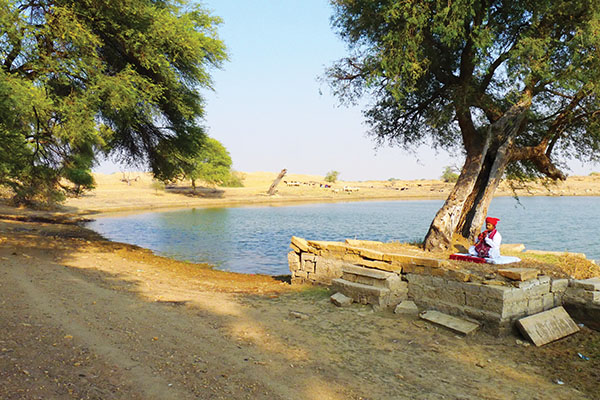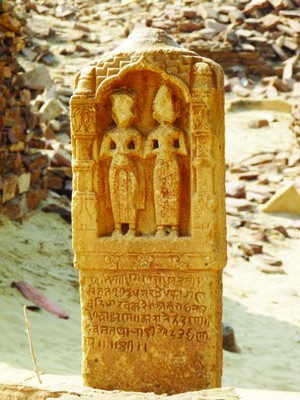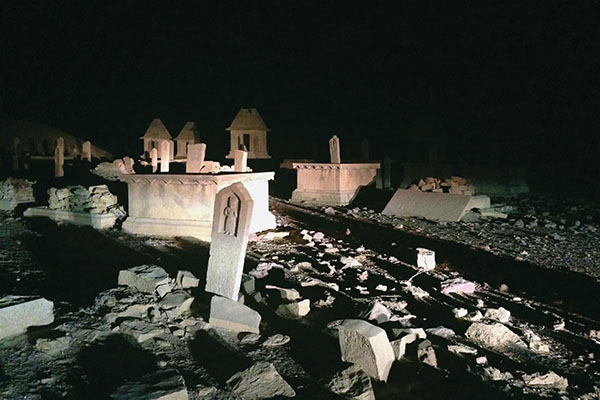
Jaisalmer and the Silk Route: An intimate acquaintance in the desert
Once upon a time, Jaisalmer was a busy pit stop on the Silk Route. Centuries later, the Thar Desert still carries the indelible marks made by merchants and farmers, warriors and musicians
The vast expanse of the unsympathetic yet romantic Thar Desert embodies a sense of the timeless, the feeling that the past is always present. And with good reason. As part of the Silk Road—a 2,000-year-old trading route that connected China to Turkey and Italy via India and central Asia—the Thar was once witness to a mirage more improbable than water: Colourful caravans travelling across the desert expanse laden with spices, silk, tapestries, precious stones and bronze ornaments, led by wealthy merchants from China, the Middle East and even Egypt, who had bet their lives and fortunes on surviving the desert.
About 400 years ago, Jaisalmer in Rajasthan became one such frequent pit stop for the travellers who preferred to cut across 320,000 sq km of the Thar rather than traverse the Pamir Mountains of Central Asia. Centuries later, their history and stories have faded from memory, but the desert remembers. The remnants of abandoned villages, fortresses and havelis can be found on a 50-km trail—organised by the fort-hotel Suryagarh—across the settlements of Khaba, Kuldhara, Kanoi and Lakhmana in and around Jaisalmer.
The genesis of the trail began in 2010, when Manvendra Singh, managing director of the Jaipur-headquartered MRS Group (which has businesses in hospitality, infrastructure and mining), was building Suryagarh, a boutique property about 12 km outside Jaisalmer city. Every evening, the 27-year-old would explore the surrounding desert to learn more about the area that would house his hotel. “The countryside has always fascinated me, and Jaisalmer’s scrub desert didn’t seem to hold anyone’s interest but mine. I found it quite beautiful and very revealing,” says Singh.
What he discovered in unnamed settlements were not just ruins, but vestiges of a surprisingly well-preserved legacy. In order to delve deeper and discover the stories behind these structures, he engaged with geologists, archaeologists, historians and locals. Compelled to know more, Singh travelled to remote parts of Rajasthan “to talk to old folk”, the unofficial repository of oral history. As his SUV made tracks and grooves in the desert, the idea of offering tourists some of these extraordinary stories he’d accumulated began to take root. Today, Suryagarh’s Desert Trail allows guests the opportunity to immerse themselves in this chapter of Jaisalmer’s history.
Suryagarh prompts you to take a step back in time: The stunning 40-acre property has been built using architectural cues from old forts and Paliwal temples in and around Jaisalmer. Its ramparts, moat, carved pillars and even the lattice work are emblematic of the region. With its quiet luxury, the boutique hotel offers guests a respite from Jaipur’s rather aggressive brand of tourism. After exploring the property, I spent my first day doing what most visitors to the city do. I visited the Jaisalmer Fort (Sonar Quila), Gadsisar Lake and Patwon Ki Haveli and experienced dune bashing (a form of off-roading).
The next morning, after a halwai breakfast (the hotel’s speciality) of kachori, samosa, chaat and perfectly sticky gulab jamun, I clambered into an SUV, and embarked on the Desert Trail. With Singh as my guide, myths and legends got a new lease of life; old tales became plausible; cemeteries seemed to hold great treasure and temples in the middle of nowhere became landmarks of culture. Above all, I was afforded a lens through which the Silk Route with its hefty history became visible.
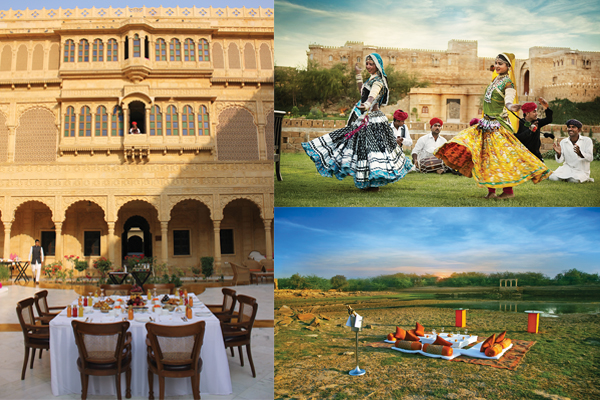
(Clockwise from left): A picnic at an oasis is a popular way to experience the Desert Trail; Kalbeliya dancers at Suryagarh; Breakfast in Suryagarh’s open courtyard is complemented by folk music played by a Manganiyar musician
At first glance, the stark desert landscape seems to hold little beauty, just endless land and sky. Going off road, however, we begin to see old structures, markers, water basins, dilapidated rest-houses and crumbling wells. The first stop on the trail is Khaba Fort, which stands at the intersection between Sindh and Jaisalmer along the Silk Route. It is believed to be 700 years old, and I can imagine merchants gathering at the fort for the night, protected by the ruling Rajputs, eager to trade with the neighbouring community. Khaba Fort overlooks one of the 84 abandoned settlements where the Paliwal community once thrived. “So far, only 81 settlements have been found. The Paliwals abandoned their homes around 250 to 300 years ago,” says Singh. A flight of stairs from the fort leads to the settlement.
The Paliwals were excellent herdsmen and agriculturalists, and even better traders. I’m told that at one time, almost all trade in the country passed through Paliwal hands. They dealt with bulls, horses and precious incense which they produced from the Boswellia, or frankincense tree, locally called the Googel plant, which is grown in some parts of Jaisalmer even today.
Due to the dearth of any written history, there are plenty of legends about the Paliwals. Locals say nearly three centuries ago, the entire community disappeared in 24 hours, leaving behind everything but a few valuables. One story behind their sudden departure involves a debauched diwan called Salem Singh, who had a harem of young girls, married multiple women, and even killed those who refused his advances. But when he turned his attention to the Paliwal chief’s daughter, community members decided that they would rather abandon their settlements than let one more girl pay the price for their inability to stop the diwan. Historians, however, believe the settlements were abandoned as the result of a contamination or desecration of the water resources that the Paliwals held in reverence. This theory is the most plausible explanation, and is underscored by the complex system of three-tiered tanks near the village wells that have survived the ravages of time. Paliwals used the first tier to store drinking water for human consumption, the second was used for bathing and utilities, and the third tier was for cattle to drink from.
Walking among the ruins of these settlements, which the Paliwals ingeniously built to encourage community activities and discourage the harsh desert sun from hampering their daily lives, is an extraordinary experience. I return to the SUV and head back to the fort where I climb up a flight of stone stairs that leads to a temple dedicated to Devi Hinglai, an incarnation of Mahishasur Mardini (a version of goddess Durga). It’s believed to have been in existence even before Fort Khaba was built. A delightful old pujari with a long white beard tells me that when the Paliwal Brahmins decided to abandon their village, they wanted to take their patron goddess with them. But no matter how hard they tried, the statue could not be moved. I bow to the divine and take my leave.
Back in the vehicle, we go deeper into the desert. I see an acre-long patch of green. Though it looks like a mirage, Singh explains that it is farmland which uses irrigation techniques that had been developed by the Paliwals, who were skilled farmers and believed in working with nature. Growing pearl millet and cluster beans, they developed various techniques to harvest water in the arid land—these have been inherited by farmers today. By creating a sloping catchment area called aagor, a higher flatland composed of iron ore gravel and a high layer of gypsum that doesn’t allow seepage of rainwater, they guided water to a lower, fertile depression where farming was possible. Another technique included building khadeens, community farms around oases where lower lands behind the bund remain submerged during the rains. Though these processes are centuries old, they remain some of the cheapest and easiest techniques of desert farming to this day. Another irrigation method was the dhora system, where fields were irrigated by a network of small drains (or dhoras). One look and I begin to understand the respect the Paliwals had for water.
The next stop in the trail is Mundhari village, known for its spring wells that have the purest water in Jaisalmer. The source of water remains a mystery; locals insist that a river once flowed through the village. Under the beating sun, a villager lowers a bucket into the well. On tasting the sweet, pristine, deliciously cool water, I felt, for a brief moment, that I had grasped the hands of my ancestors.
This continuity of culture becomes all the more visible as we drive to one of the highest points in the deserts, the Nabh Dungar temple. A sentinel of time and culture, the temple’s peak has a Chinese motif of a lion, a reflection of the trade and exchange of religious ideas that India had with its neighbours, courtesy of the Silk Route. Hawks fly in gyres over the temple, while smaller birds hop on the rocky outcrops. The desert no longer feels that harsh.
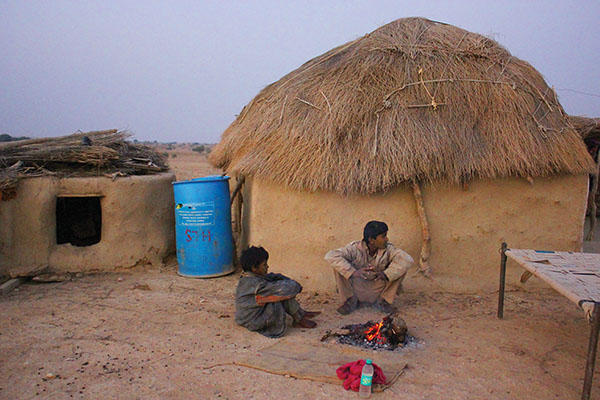
Tradition vies for space with modernity at a Bhil settlement in the scrub desert
We then move on to a Bhil village, characterised by small makeshift houses called dhanis. Natives of Jaisalmer, the nomadic Bhils follow the ways of their ancestors, and continue to rear cattle as a primary source of income, working on farms owned by others only to supplement their earnings. “The Bhils have taken an oath that they will not own farm land. The local legend is that the Bhils are the descendents of goddess Parvati’s brothers,” says Suryagarh hotel manager Nakul Hada, who is driving the SUV. Centuries ago, the goddess asked her husband Shiva to bless her brothers. The brothers not recognising his first blessing—a silver pot that had been placed near their belongings—walked away. Parvati asked her husband to bless them again. Shiva agreed to give them his precious Nandi (bull); Parvati told her brothers that this gift would bring them prosperity and happiness. In their impatience, the brothers killed the animal, expecting to find wealth inside its body. For this disrespect, Parvati cursed her brothers, saying neither they nor their descendents would be able to own land.
As Hada finishes narrating the tale, we arrive at a small dhani. Made of thatch and scrub, clay and cowdung, the single-family settlement has a separate area for cattle and an outhouse. As I play with the goats, I see a cellphone in the straw. Though they cling to traditional ways, change is coming to one of the oldest communities that calls Thar Desert home.
After all that bumpy off-road driving, Singh has planned a late afternoon treat, Silk Route style. We drive to the largest and oldest functional reservoir in the area, Joshida Talao, for a wine and tea picnic. Orange parasols, white gaddas (mattresses) and golden bolsters are invitingly laid out around an old rest house. As I sink into a gadda, a Manganiyar musician takes his place under a babool tree to sing old folk songs. Manganiyars are Muslim folk artistes from Rajasthan whose ancestors survived on the patronage of Rajputs. They have a distinct gravelly way of singing, and use traditional instruments such as ravanhattas (a type of bowed violin). Orange-turbaned waiters serve us wine along with grilled meat and sandwiches and after having our fill, we listen more closely to the musician’s lyrics.
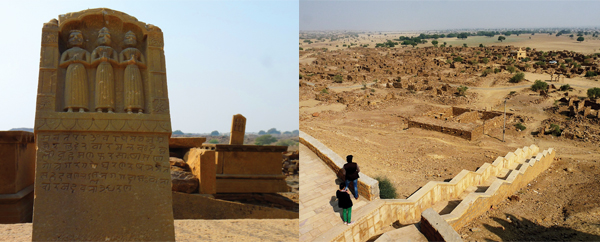
The dress and headgear in a few cenotaph sculptures point to Phoenician origins of travellers on the Silk Route; the Khaba Fort leads down to one of the 81 Paliwal settlements
The songs tell stories of Bhati heroes, the Rajput warriors credited with having established Jaisalmer in the 12th century. Excellent horse riders and marksmen, they are believed to have gained prominence in the 14th and 15th centuries. As Jaisalmer was located on the Silk Route between Afghanistan and Delhi, the Bhati Rajputs not only built numerous guest houses, but also presented stamped passports to merchants. In exchange for taxes, they offered them protection against theft. The area around the talao, in fact, has several engraved pillars called Govardhans, markers to inform thirsty traders that water was close by.
The day ends with a visit to the cemeteries near Nabh Dungar and Khaba village, memorial and burial grounds for travellers from the Far East and even Egypt who died while on the road. There are headstones with sculptures of the departed—some with styles of headgear and dress that look Phoenician—bearing dates and epitaphs that aren’t quite clear. A hot wind blows past me, and in my mind’s eye I see a caravan in the same spot I am standing at. It’s time to head back to Suryagarh.
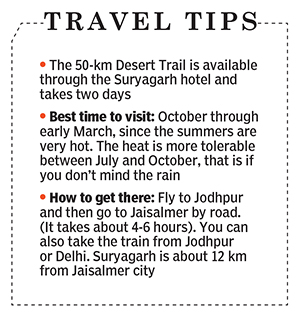
After dinner, made all the more delectable by the horror stories that Singh and Hada had narrated with great gusto, I left the hotel at midnight for a chudail trail to experience some of the most haunted places in Jaisalmer. Our departure is characterised by a blood moon, menacing yet, given the desert landscape, common. In the car, the driver recounts stories of the villainous Salem Singh and the witches who were pushed into wells by superstitious villagers. The car’s headlamps cast shadows in its wake, setting the tone for the night. The neem and babool trees near the wells, which looked welcoming in the day, appear ominous. It’s time to put aside reason and logic and embrace the ghosts of the past.
The car stops at Kuldhara village, one of the abandoned Paliwal sites, and my guide takes me to a centuries-old house, which once belonged to a wealthy family. A flight of stairs opens into a tiny basement where I’m told a woman was buried alive. With cellphones illuminating our way and nothing but the guide’s voice echoing through the empty rooms, it is difficult to remain aloof. I step out of the haunted house into the night sky lit by the red moon and what appear to be a million shining stars overhead. We pass a temple where people built small Shiv lingams on the portico to save themselves from evil spirits, and stop by Kuldhara cemetery to see the headstones under the moonlit sky.
Chilled to the bone—by the sights, stories and weather—I was, to be honest, relieved when, two hours later, it was time to head back. Our last dinner on the grounds of Suryagarh is dedicated to the Rajput hunting feast. The hotel’s chefs use dhuan and dhundar (techniques of smoking meat to tenderise and infuse flavour and aroma) to grill quail, rabbit, lamb and chicken with hardy local spices. Across the moat at the edge of our table, Kalbeliya dancers flash their skirts in unison to the beat of folk music performed by a troupe of artiste It is an amalgamation of the past and present, with music and the oral retelling of stories, of reimaginings and visions, that makes us one with the Thar in that moment of time.
(This story appears in the Mar-Apr 2015 issue of ForbesLife India. To visit our Archives, click here.)
-
 Pratibha Singh
Pratibha SinghIs it the best of the time of year to go to Jaisalmer i.e, April onwards. Iits surely impressive to know the efforts made to create a unique property so far off to travel.
on Mar 29, 2015 -
 Somveer
SomveerJaisalmer is a gem of a place. I love it more everytime i visit there. Especially the jaisalmer fort. You have covered the place very nicely. I happened to even write a blog to show respect the people how amazing it is. You can read it here : http://www.premieroutlook.co.in/things-to-know-about-people-and-lifestyle-of-jaisalmer-rajasthan/
on Dec 16, 2018
